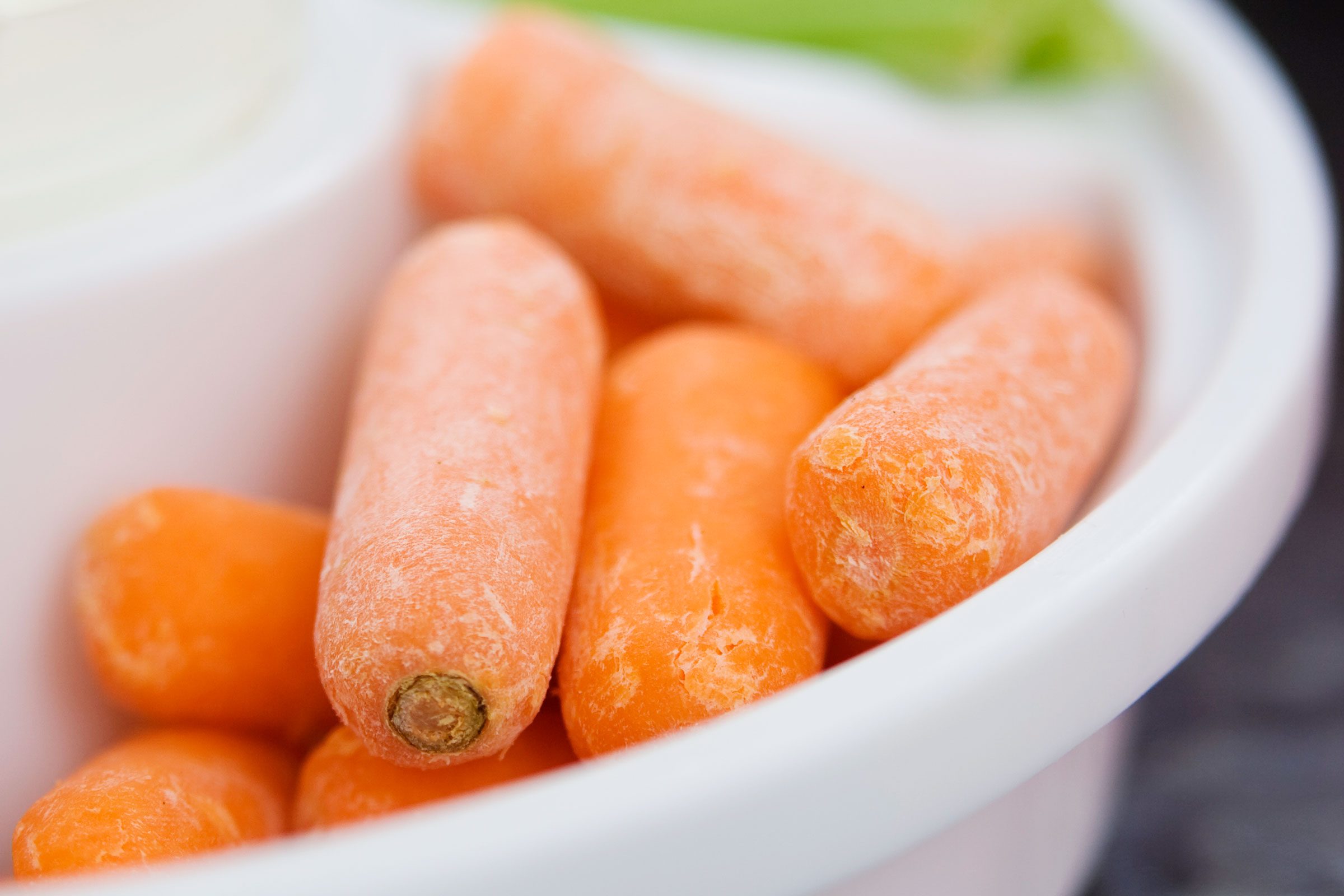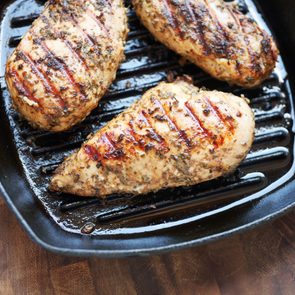Have you seen white stuff on baby carrots? Here's what it is, and why you really shouldn't worry about it.

If You See White Stuff on Baby Carrots—Here’s What It Really Is

If baby carrots are your go-to choice for healthy snacks, you’ll immediately know what we’re talking about here. You grab the bag from the fridge, but as you open it, you notice some white stuff on baby carrots! Gasp! What the heck is it? Is it a sign that your carrots are going bad? And is it even safe to eat anymore?
It turns out that there’s a simple scientific reason this year-round vegetable sometimes has that white stuff on it. And although it can be alarming to many, much like seeing the weird white stuff on oranges, it’s completely normal to see this white coating on baby carrots. In fact, it’s so normal that plant expert Pol Bishop and Susan Brandt, co-founder of Blooming Secrets, are helping us spread the word about what the white film means.
So read on to learn just what the white stuff on baby carrots is, plus why it’s there in the first place.
Get Reader’s Digest’s Read Up newsletter for more fun facts, humor, cleaning, travel and tech all week long.
What is the white stuff on baby carrots?
You may have heard that the white stuff on baby carrots is chlorine, but that’s just a half-baked food myth. It’s not mold either! The white coating you sometimes see on carrots is actually caused by dehydration. This thin layer of film is known as “carrot blush.” It is harmless and surprisingly common—leave baby carrots out on the kitchen counter on a hot summer day and you might just return to see some carrot blush (in white, that is).
How does carrot blush form?
According to Bishop, carrot blush forms when baby carrots lose moisture when exposed to a dry atmosphere. “Moisture loss in the thin outer layer of the baby carrot causes its surface to roughen up and light to be scattered throughout it,” says Bishop. “All this results in whitish marks on the carrot.” White blush can also appear due to the carrot’s damaged skin cells.
So, why does this white film only form on baby carrots and not regular carrots? The answer lies in a surprising food fact. “This happens because baby carrots do not have [the] protective skin that prevents drying,” Brandt explains. During the mechanical process of shaving the carrots down to their “baby” size, the veggie also loses its protective layer—which the scientists call “periderm”—causing it to lose moisture a lot quicker than regular carrots, which, as Brandt notes “do have protective skin.”
Is it okay to eat the white stuff on baby carrots?
Absolutely! Carrot blush is harmless, as it’s just a sign that your baby carrots are dehydrated. False claims that white coating is caused by chlorine are common, largely because baby carrots are indeed dipped in a mild chlorine treatment solution as an anti-bacterial measure. However, as explained further by Iowa State University’s Nutrition Program Specialist Jody Gatewood in an article: ‘The baby carrots are thoroughly rinsed in water after the FDA-approved two-minute chlorine dunk—making chlorine an unlikely culprit for the carrot blush.”
How do I remove the white stuff on baby carrots?
You don’t need to make a vinegar wash. You can easily remove the white stuff on baby carrots by simply washing them. You can also soak your carrots in water to rehydrate them and bring back their vibrant orange color. But just like speckled and bumpy eggs, we understand if they still don’t look quite right—even though science confirms that carrots with a white coating are perfectly safe to eat. If that’s the case, you can also cook the carrots to make them visually (and mentally) appetizing again. To keep them healthy, try some roasted crispy carrot fries or carrot tots in the air fryer. Yum!
Is the white stuff on baby carrots a sign they’re going bad?
According to Brandt, carrot blush is not a sign your baby carrots are going bad; just that they’re dehydrated. It’s also not a warning that you need to eat them right away before they go bad: It simply means they’ve dried out a little. So, don’t fret if you’re snacking on carrots and eat some of this white film—it’s not harmful. That said, there are a few signs that mean it’s time to toss your carrots in the compost instead.
How can you tell if baby carrots have gone bad?
If you store your fresh produce properly, carrots in your fridge will likely last for two to three weeks. But even when refrigerated, fresh produce can go bad due to many (seemingly) mysterious reasons (think of that summer when your power went out for half the day or when you mistakenly stored ripe apples right beside your carrots, a classic fridge organization mistake). Here are some signs that tell you your healthy snack is not so healthy anymore:
- Mold: Seeing mold on your baby carrots is a clear sign to toss them. While the USDA notes that a singular, small mold spot can be safely cut off and the rest used—provided you cut at least an inch around it—mold in multiple spots means it’s time to play it safe and throw the whole carrot out.
- Odor: Smelling a pungent odor is also a sign that the carrot is not safe to eat. This funky smell means that the carrot is already going through a microbial or chemical breakdown. In other words, the bacteria are winning. Tossing them in the compost is a good idea.
- Slime: Feeling a slimy layer? This goop-y substance on your carrots is another sign of bacterial growth. If you’re wondering, simply washing the slime away does not alter the chemical process the carrots are going through—so consider them unsafe to consume.
How can you keep baby carrots fresh longer?
Timely refrigeration is just one of the many tricks that help you keep fruits and veggies fresh longer. To keep your baby carrots fresh, preventing moisture loss is essential. You can store your baby carrots in containers with a lid on or in zip-lock bags. If you have neither, tightly wrapping them in aluminum foil or plastic wrap works too.
You can also freeze your baby carrots if you accidentally bought too many and want to keep them fresh for extended periods of time. However, remember that thawed carrots are better suited for cooked dishes like soups and stews rather than raw ones like salads that you’d expect a crunch in.
About the experts
|
Why trust us
At Reader’s Digest, we’re committed to producing high-quality content by writers with expertise and experience in their field in consultation with relevant, qualified experts. We rely on reputable primary sources, including government and professional organizations and academic institutions as well as our writers’ personal experiences where appropriate. For this piece on the white stuff on baby carrots, writer Kelly Kuehn tapped her experience as a former editor for Reader’s Digest, along with interviewing gardening expert Pol Bishop and Susan Brandt, the co-founder and president of Blooming Secrets. We verify all facts and data, back them with credible sourcing and revisit them over time to ensure they remain accurate and up to date. Read more about our team, our contributors and our editorial policies.
Sources:
- Pol Bishop, gardening and plant expert at Fantastic Gardeners
- Susan Brandt, co-founder and president of Blooming Secrets
- U.S. Food and Drug Administration: “Guidance for Industry: Guide to Minimize Microbial Food Safety Hazards for Fresh Fruits and Vegetables”
- Iowa State University Extension: “Baby Carrots–Myth and Facts”
- Iowa State University Extension: “Baby Cut Carrots: Healthy or Harmful?”
- United States Department of Agriculture: “Molds on Food: Are They Dangerous?”






















